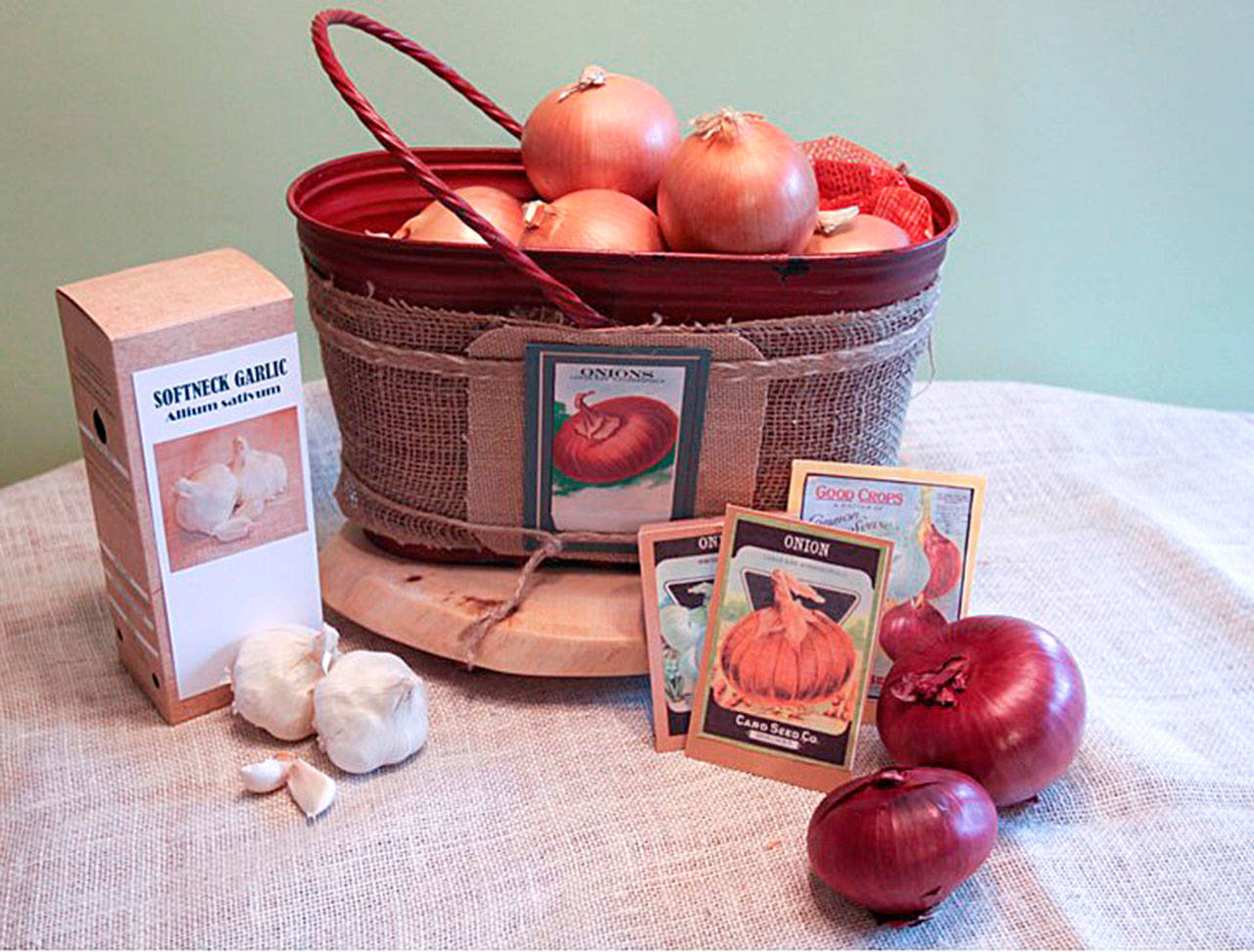by Michele Mangiantini
The Olympic Peninsula provides a perfect climate for growing garlic (Allium sativum) and onion (Allium cepa). Easy to grow with a long storage life, garlic and onion are culinary staples that add nutrition and flavor to our diets.
When selecting for the home garden, consider varieties best suited for our climate:
Garlic comes in two types (subspecies); hard and soft neck varieties. The most cold-hardy is the hard neck with cloves that grow around a stiff stem. They are milder in flavor and do not store as well as the soft neck types.
Soft neck garlic is more commonly found in grocery stores, has a white, papery sheath and a softer stem. Elephant or great-headed garlic (Allium ampeloprasum) isn’t truly garlic and is more closely related to leeks.
Elephant garlic is milder than and not as hardy as true garlic.
Onion types are more about the different stages of growth. Green onions and scallions are just immature onion bulbs. Onion bulbs are formed at the end of the first season and store energy for flower and seed production in the second growing season.
Onion sets are small bulbs grown from seeds the year before. Seedlings are small plants started from seeds earlier in the current season. Northern gardeners should select “long-day” varieties to produce big bulbs.
Even though both are members of the lily family, garlic and onions have very different planting and growth patterns:
Garlic is a perennial that is grown and harvested annually. It is best to buy certified seed garlic from a nursery or garden store to assure disease-free/pest-free stock. Plant seed garlic in fall, allowing root development before the ground gets too cold.
Break apart a bulb and immediately plant the larger cloves with the pointy tip up, 2 inches deep and 4-6 inches apart. Use a seed-free mulch to protect from winter elements. Garlic will go dormant during winter and begin the growth stage in spring.
In summer, depending on the variety, garlic may produce flower stems called “scapes.” Scapes are edible and are most flavorful when they’ve begun to curl. Carefully pinch or cut off scapes above the top-most leaf of the plant. When scapes are removed plants focus more energy on bulb production for a July-August harvest.
Harvest garlic when most of the leaves have turned brown. When the plant starts to decline, stop watering for at least a week. Using a shovel, gently dig them up, remove all of the soil and cure several weeks in a cool, well ventilated location. Properly cured garlic will store for several months.
Onions are biennial plants, meaning they grow from seed to flowering in two seasons, using the first season for vegetative growth and the second season for flower and seed production. Seeds, seedlings or sets should be planted in spring as early as the soil can be worked.
Seeds can be started indoors 4-8 weeks before planting outdoors. Plant seed 1½-2 inches apart and cover with ½-1 inch of loose soil. Thin (and eat) seedlings when they reach 3 inches tall, spacing to 4-inch centers for full size bulbs or less for green onions.
When leaves and stems begin to fall over it is time to harvest. Allow to dry or cure for a few days before storage.
Garlic and onions are shallow rooted plants that do not compete well with weeds. They also require full sun and do best in soil that stays relatively constant in moisture.
Avoid planting Allium plants together and place them in a three-year garden rotation to reduce carryover of pathogens, as Alliums carry the same diseases and pests.
Michele Mangiantini is a Clallam County Master Gardener.
Learning with the Clallam County Gardeners
• Saturdays in the Garden Series
Woodcock Demonstration Garden — 2711 Woodcock Road, Sequim
June 17 topic: “Using Ornamental Grasses in the Landscape,” 10-11 a.m. with Master Gardener Janet Oja
• Annual Garden Tour
June 24, 10 a.m.-4 p.m.
A unique opportunity to gain inspiration from private gardens within our community. For ticket sales and garden locations, visit ext100.wsu.edu/clallam.
• Plant clinics
Plant clinics are opportunities to get help and information for solving gardening problems.
9:30 a.m.-12:30 p.m. Mondays at the Clallam County Courthouse, 223 E. Fourth St., Port Angeles
9:30 a.m.-12:30 p.m. Saturdays at the Woodcock Demonstration Garden, 2711 Woodcock Road, Sequim
Using what you grow
Onions, garlic and other members of the Allium genus are naturally sodium, fat and cholesterol-free. Although high in vitamin C, fiber and several minerals, when eaten in the amounts used for most recipes, they have limited nutritional value. Onions and garlic, however, add abundant flavor to a wide variety of food.
Tofu Vegetable Stir Fry with Garlic
From San Francisco Human Services Agency’s eatFresh.org
Ingredients:
1 teaspoon vegetable oil
2 cloves garlic, minced
1 cup (one medium) onion diced
2 cups seasonal vegetables (such as cabbage, carrots, bell peppers, broccoli), chopped
2 Tablespoons soy sauce
2 Tablespoons water
1 cup firm tofu, cut into cubes
Black pepper to taste
Directions
1. Heat oil in hot pan for about 1 minute.
2. Add onions and garlic and cook, stirring frequently, until soft. This takes about 2 minutes.
3. Add other vegetables and tofu. Cook for about 3 minutes until pieces brown a little and give off steam.
4. Add soy sauce and water to pan. Cover and turn heat down to medium-low.
5. Continue cooking until all ingredients are tender. This will take 5-10 minutes.
6. Add black pepper. Serve with rice noodles.
Consider substituting tender garlic scapes for the minced garlic. The flavor is milder and doesn’t compete as much with other flavors in the dish. After washing, cut the scapes into 2-inch long bite size pieces, discarding the buds. Add the scapes at the same time as the seasonal vegetables.



